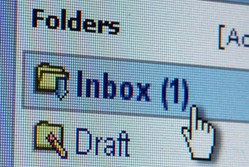Choose the right type of business email system
 Like so many areas of IT, when you start investigating the best way to get business email, you’ll probably run into a wall of jargon. A good IT supplier can help guide you through the various types of business email service, but here’s our guide to the four business email technologies you may be offered
Like so many areas of IT, when you start investigating the best way to get business email, you’ll probably run into a wall of jargon. A good IT supplier can help guide you through the various types of business email service, but here’s our guide to the four business email technologies you may be offered
- POP3
- IMAP
- Microsoft Exchange
- Webmail or HTTP
Its full name is post office protocol 3, but everyone simply calls it POP3. With a POP3 email service, your email messages are downloaded to your computer and then usually deleted from your central email server.
If you use POP3 to receive business email, you’re usually restricted to using one computer for your email. (Each person can have their own email account, but everyone will be restricted to their own computer.)
Most email addresses that come as part of your internet connection package are POP3 accounts.
IMAP stands for internet message access protocol. It’s an alternative to POP3 which keeps messages stored on a central business email server, along with information about whether each message has been read or replied to.
With IMAP, you can log in from any computer and see your whole inbox, complete with the status of messages – so you can see which you’ve read, which you’ve replied to, and so on.
IMAP is a good way to add extra flexibility to your business email. It’s a well-established technology and you’ll find many entry-level email services (like those from web hosting companies) will include IMAP as standard.
Exchange is a proprietary email system created by Microsoft. In the past you had to install Exchange onto your own email server in order to use it, putting it out of reach of most small companies.
However, it can now be bought online as a monthly service. It’s often called Hosted Exchange or Exchange Online and is really a form of cloud computing.
Like IMAP, Exchange stores messages centrally, so you can log in from different places. But it also offers lots of extra functions, including centrally stored calendars, task and contact lists.
You need Microsoft’s business email software – Outlook – in order to use Exchange to its full potential.
However, many businesses find the additional functions are worth having. And services like Microsoft’s Business Productivity Online Suite often include the software, which can be more cost-effective.
Email on your mobileThese days, it’s not enough to send and receive email from your computer. Many people want to get email on their mobile devices too. Usually, it’s no problem. Most mobile phones and tablet devices can connect to POP3 and IMAP services easily. Many also work with Microsoft Exchange – and webmail services offer special sites for people using mobile devices. |
As the name suggests, webmail services require you to use a web browser (like Internet Explorer or Firefox) to log in and access your business email. Some people call them HTTP email services.
Many free business email services – including Hotmail, Yahoo Mail and Google Mail – are webmail services.
To send or receive email, you visit a specific website and log in with your username and password.
Webmail is convenient because you can log in from anywhere. However, it’s useless unless you’re connected to the internet, meaning most companies prefer to use another business email service which also offers webmail as an option.
For instance, Microsoft Exchange includes a webmail interface, so you can check your business email if you’re not at your own computer. So do many of the IMAP and POP3-based services available.
Popular content on email:
- Ten ways to use email effectively
- Sample email use policy
- Streamline your email and save time
- Choose a bulk email service provider
Find more articles, videos and tools on communications in the ‘Resources’ box.




